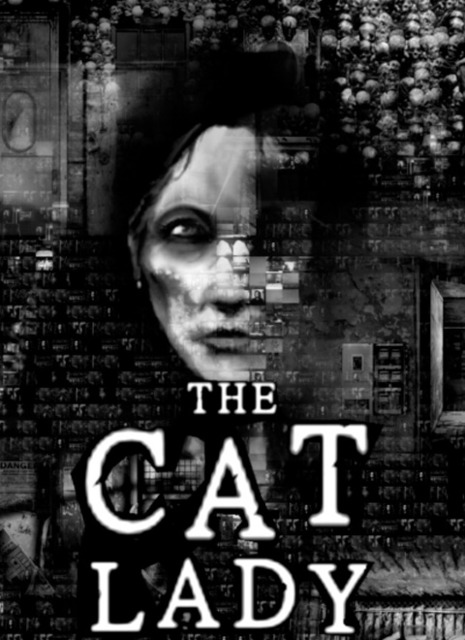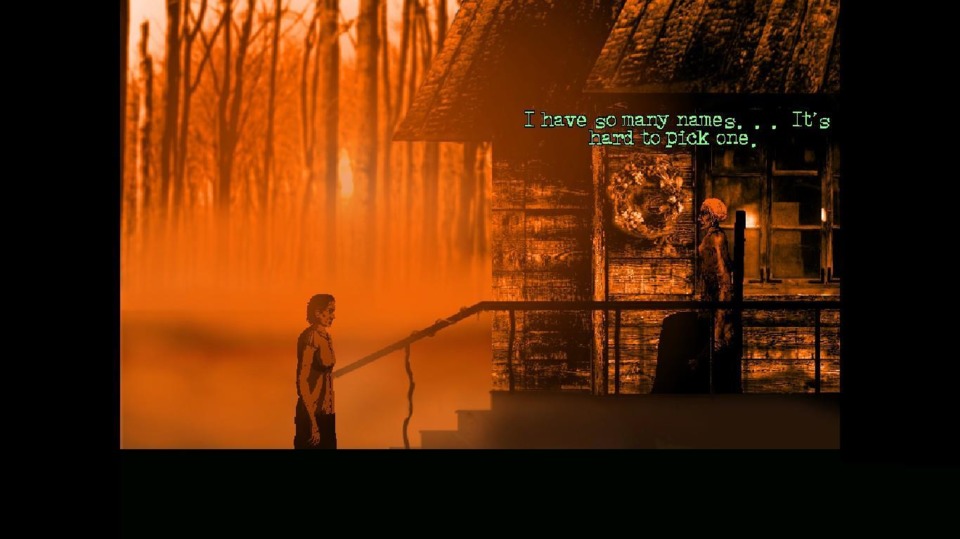
Oh boy, in retrospect I'm not quite sure I was in a good place for this one. However, The Cat Lady has something of a glowing reputation for being, let's say, a challenging game and not in the traditional sense. As I continue to expand my horizons as far as the Indie scene goes, and in particular adventure games of every conceivable stripe and color that emerges from same, Harvester Games's psychological horror game stuck out as a worthy candidate. The Cat Lady follows Susan Ashforth, a chronically lonely middle-aged woman and the titular feline fan, who starts the game mid-suicide attempt. It only gets more bleak from there, as she awakens in a nightmarish metaphysical plane between the world of the living and the world of the dead. She's given an ultimatum from the "god" of that place, the Queen of Maggots: to exterminate five "parasites" - humans that exist only to cause suffering and death - in exchange for her own soul. To ensure she follows through with this, the Queen then curses the miserable Susan with immortality, forcing her to come back to life over and over until her task is complete. Worse, you learn pretty quickly that each resurrection costs someone else their life - a soul for a soul.
Though the game has a strong supernatural bent, its attention is focused on the nature of depression and the harm it causes. The game's aesthetic is this deliberately unappealing, gray, discordant, gritty view of the world, based in equal parts on the drabness of city living and Susan's own nihilistic filter. The oppressive desaturation comes into sharp contrast with the vivid reds of the lairs of the parasites; all invariably psychopaths, all of whom find their paths crossing with Susan due to circumstances presumably of the Queen of Maggots's doing. Mechanically speaking, the game takes place across a series of interlocking 2D planes, with interactive hotspots placed in the foreground and background. A large portion of the game is given over to traditional adventure game puzzles, of the type where you use the right items and contextual commands on hotspots to progress, but the game gives an equally substantial amount of screentime to purely narrative functions, like long dialogue cutscenes and other vaguely cinematic flights of fancy. Released in 2012, it was part of that early wave of Indie adventure games to really start pushing beyond the boundaries of the classic point-and-click template, finding ways to tell stories in a narratively-enriched but still video game medium-exclusive format - games like Dear Esther, Her Story, Gone Home, Virginia, Sunset, and others, which rely on the player's participation to tell their stories in their own specific manner. I say point-and-click, but The Cat Lady is distinctive in that it's entirely controlled via keyboard: the left and right arrows (or A and D) move Susan, while up (W) interacts with environmental hotspots and down (S) accesses your inventory. It's an elegantly simple control scheme, though there's something almost off-putting about the lack of any kind of mouse functionality. But then, I suppose "off-putting" is the game's goal in many ways.

The characterization of Susan is curious, in that she has to be this strong narrative construct to carry the game almost on her own, but the player is afforded a few opportunities to put their own spin on her backstory. For instance, she's required early on to complete a psychological interview to be discharged from hospital after she recovers from her initial suicide attempt, and through this the player can make choices reflecting her backstory: her relationship with her parents, her career path, aspects about her day to day routine, and the effect depression has had on her life. That psych evaluation don't play much of a role in the ensuing events - no branching paths based on those choices that I could ascertain - but they at least lend the game a personal touch, and the chance to shape the character in some small way to befit her story as the player perceives it. It felt a little bit like a callback to the therapy session framing device of Silent Hill: Shattered Memories, which had subtle effects on the subsequent chapters. Speaking of references: for as dour and unnerving as the game could be with its unpleasant encounters and grimy look, it's kind of a big dork at heart. Each of the parasites seems to reference something, whether it's BioShock's creepy artist Sander Cohen, or the novels of Stephen King, or even a riff on Maniac Mansion - the Ur example of horror-themed adventure games, you might claim - though most have been dialled up to an even more disturbing extent.
It's certainly not a game for the squeamish, as Susan's ability to come back from anything means she finds herself creatively murdered quite a lot. Yet, for as bleak as the game can be, there's a message of hope if the player decides to work towards it. Each attempt to kill Susan, or control her, strengthens her resolve to live and to defeat the sickness that has controlled her life for so long. There's also a handful of moments of levity, if only to ensure the atmosphere doesn't become so oppressive as to smother any enjoyment that could be taken from the story, and the voice acting is generally excellent (barring a few lines which didn't quite get the inflection they required). For as ugly as the game can be (again, on purpose) some of its visuals can be downright arresting, and that's doubly true for the symbolic imagery of the otherworld plane Susan occasionally finds herself revisiting and the macabre dens of the parasites. The puzzle difficulty settles into a good place also, never giving you too many hotspots to deal with at any one time and ensuring most of the solutions can be arrived at logically, or if not logically than with some amount of hinting.

However, the game can be a bit rough around the edges. I don't just aesthetically, but in terms of typos and other minor errors. I particularly didn't care for the fact that the game doesn't auto-save at any point, and in my save cycling cautiousness I managed to mess up by attempting to quick-save to the fifth slot by hitting F5: there is no fifth slot, and F5 loads the first quick-save slot instead. I lost about an hour of progress due to that mistake. There's a few glitches here and there also, such as a character repeating the same audio line while they continue to converse normally in subtitles, and the way characters will occasionally get stuck behind walls and doors at the terminal ends of the current screen. Minor stuff, none of which caused any game-breaking bugs, but were perhaps indicative of the instability of the platform (the game was created through the open -source Adventure Game Studio engine, which The Cat Lady takes in some directions it perhaps wasn't built for). Beyond the annoying save feature, there was nothing about that roughness that ultimately proved too distracting or deleterious, but all the same the game could've used a little more polish in spots.
On the whole, The Cat Lady is a grim and personally challenging story about the rigors of depression, and the idea (which I subscribe to) that it's an ever-present adversary that exists only to sap the will to live from otherwise functional people, that I'm nonetheless pleased I took the time to finally check out. Sometimes I find these misery games a little too much to bear - I struggled whenever The Banner Saga kept knocking me down with sudden turns for the worse, and I flat-out noped my way clear of Papers, Please and Cart Life - but The Cat Lady's balance of striking visuals, tense horror and enjoyable puzzles was enough to buoy my way through the difficult subject matter. I couldn't wholeheartedly say that I enjoyed my time with it, but that time certainly wasn't wasted. (I might have to try out the game's sorta-sequel, Downfall, in the near future.)
Rating: 4 out of 5.
| < Back to 64: Infinifactory | > Forward to 66: Eschalon: Book I |
Log in to comment